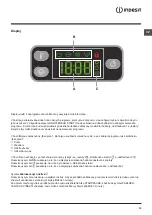
4
GB
Care and maintenance
Cutting off the water and electri-
city supplies
• Turn off the water tap after every wash cycle.
This will limit wear on the hydraulic system
inside the washing machine and help to pre-
vent leaks.
• Unplug the washing machine when cleaning
it and during all maintenance work.
Cleaning the washing machine
• The outer parts and rubber components of
the appliance can be cleaned using a soft cloth
soaked in lukewarm soapy water. Do not use
solvents or abrasives.
• The washing machine has a “Auto Clean”
programme for its internal parts that
must be
run with no load in the drum
.
For maximum performance you may want to
use either the detergent (i.e. a quantity 10% the
quantity specified for lightly-soiled garments) or
special additives to clean the washing machine.
We recommend running a cleaning programme
every 40 wash cycles.
To start the programme press buttons
A
and
B
simultaneously for 5 seconds
(see figure).
The programme will start automatically and will
last approximately 70 minutes.
Cleaning the detergent dispenser
drawer
Remove the dispenser
by raising it and pulling
it out (
see figure
).
Wash it under running
water; this operation
should be repeated
frequently.
Caring for the door and drum of
your appliance
• Always leave the porthole door ajar in order
to prevent unpleasant odours from forming.
Cleaning the pump
The washing machine is fitted with a self-clea-
ning pump which does not require any mainte-
nance. Sometimes, small items (such as coins
or buttons) may fall into the pre-chamber which
protects the pump, situated in its bottom part.
!
Make sure the wash cycle has finished and
unplug the appliance.
To access the pre-chamber:
1. using a screwdri-
ver, remove the cover
panel on the lower
front part of the wa-
shing machine (
see
figure
)
;
2. unscrew the lid
by rotating it anti-
clockwise (
see
figu-
re
)
:
a little water may
trickle out. This is
perfectly normal;
3. clean the inside thoroughly;
4. screw the lid back on;
5. reposition the panel, making sure the hooks
are securely in place before you push it onto
the appliance.
Checking the water inlet hose
Check the inlet hose at least once a year. If
there are any cracks, it should be replaced
immediately: during the wash cycles, water
pressure is very strong and a cracked hose
could easily split open.
!
Never use second-hand hoses.
A
B





































